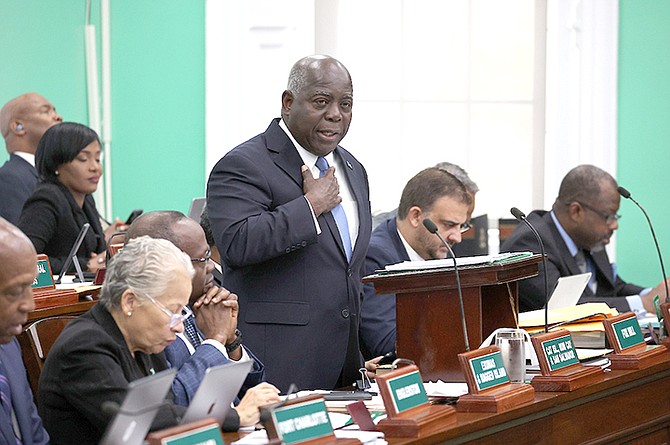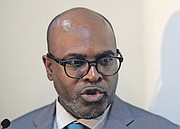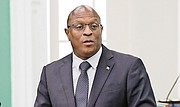• No changes despite 97% half-year overshoot
• Pintard blasts: PM ‘has busted his Budget’
• Governance reformer eyes ‘$300m range’
By NEIL HARTNELL
Tribune Business Editor
nhartnell@tribunemedia.net
The Government has not adjusted any of its 2023-2024 fiscal targets despite revealing yesterday that its $258.7m half-year deficit was almost double the full 12-month goal.
Philip Davis KC, in unveiling the mid-year Budget statement in the House of Assembly, disclosed that the deficit for the six months to end-December 2023 was equal to 197 percent of the $131.1m full-year target that was set last May.
However, documents accompanying the Prime Minister’s presentation showed no changes or adjustments to any of the original revenue, spending or deficit numbers. Simon Wilson, the Ministry of Finance’s financial secretary, told Tribune Business last night he remains “very confident” the Government can meet its targets for the public finances despite overshooting the full-year target by $127.6m in just six months.
Pointing to “healthy double digit growth” in revenues, with collections meeting forecast from November 2023 onwards, the Government’s top finance official said the Budget’s cyclical meant it was impossible to predict the full-year outcome based on the first six months’ performance.
Economic activity during that period, which covers the second half of the calendar year, tends to be relatively weaker prior to the Christmas/New Year holiday season and has a corresponding effect on the Government’s finances. Instead, it tends to receive the bulk of its revenues during the calendar year’s first half, which coincides with the peak winter tourism season and Business Licence fee payments.
Increased departure taxes on cruise ship passengers and other levies also kicked-in from New Year’s Day. Asked how strongly the Government’s income has held up for the 2024 calendar year-to-date, Mr Wilson said: “The revenues from November have been performing in line with expectations largely.
“In some areas more work is required, but overall we see healthy double digit growth in revenues. We have to move and continue working. We cannot rest on our laurels. The Prime Minister referred to the primary surplus showing that, from a cash perspective, we’re doing OK but we cannot become too comfortable.
“There’s more work to be done. We still have three-and-a-half to four more months of hard work. The first six months have demonstrated that, from a revenue perspective, we’ve held the line in this slower period so we’ve got to continue working.”
Mr Davis did not dwell long on the first-half deficit during his mid-year Budget statement yesterday, instead moving swiftly to try and focus attention on the primary surplus achieved by his administration. The primary balance strips out interest payments to measure whether the Government’s revenues are covering all its fixed-cost spending bar debt servicing.
“During the period, the Government experienced a net deficit of $258.7m, which represented a decrease of $19.1m relative to the previous comparable period. At the half-way mark in this fiscal year, the deficit exceeded the (full-year) Budget forecast by $127.6m,” the Prime Minister acknowledged.
“However, the primary balance improved from $3m in the first half of the 2022-2023 fiscal year to $42.4m for the first half of the2023-2024 fiscal year. The primary balance is the best measure of fiscal health. That is the best measure, and it is expected to continue in that fashion.”
Echoing Mr Wilson’s position, Mr Davis said the primary surplus indicated the Government is enjoying positive cash flows. He suggested it was the public finance equivalent of the private sector’s definition for earnings before interest, taxation, depreciation and amortisation (EBITDA).
The full GFS deficit, by contrast, measures by how much the Government’s spending exceeds its revenue income although it does not include debt principal repayment. It also serves as indicator of how much net new borrowing the Government has to undertake to close this gap, which for the six months to end-December 2023 was almost $259m, and make ends meet.
Others, though, yesterday voiced scepticism that the Davis administration will hit its 2023-2024 fiscal goals. Michael Pintard, the Opposition’s leader, blasted that it was “pure fantasy” for the Government to still believe it will hit the $131.1m full-year deficit target based on its first-half performance, and accused Mr Davis of “busting his Budget”.
Describing the deficit revelations as “the big take away” from the mid-year Budget statement, Mr Pintard told Tribune Business: “As the Opposition warned, as the rating agencies warned, if the Prime Minister continued on the path he was going on his projections of being able to meet his targets were pure fantasy.
“We don’t believe the Government has any real commitment to that because very few, if any, of the measures he needed to take he took. He busted his Budget.... When we compare it [the half-year deficit] to the full-year, it is already at $258.7m, some $127m more. It is a dramatic increase in terms of having gone beyond the targeted numbers.”
Hubert Edwards, the Organisation for Responsible Governance’s (ORG) economic development committee head, told this newspaper that while the 2023-2024 full-year deficit is likely to come in closer to the International Monetary Fund’s (IMF) $379m forecast than the Government’s $131.1m, achieving the former is “certainly positive” still.
This is because $379m would still represent a $150m-plus deficit reduction compared to 2022-2023’s $533m worth of ‘red ink’. And Mr Edwards warned against the “mistake” of simply assuming the full-year deficit will be double the half-year’s, and exceed $500m, due to the fact the Government will now be earning the bulk of its annual revenues.
“It’s likely to terminate in that $300m range,” Mr Edwards predicted of the deficit. “If it comes in at or below the IMF’s projection it still represents a continued downward trajectory. That stands as a positive, and we should look at it against a projection [the Government’s] as being too much on the aggressive side given all the circumstances we faced.”
The Prime Minister yesterday hailed that both total revenue and tax collections for the 2023-2024 first half had increased compared to the prior year. “For the first six months of the year, preliminary total revenue collections are assessed at $1.3bn, which represented a $43.8m increase over the same period of the prior year. To date, revenue collections accounted for 39.2 percent of the annual budget target,” he said.
“Stronger collections are expected in the second half of this fiscal year, reflecting the cyclical nature of the fiscal year. In addition, the revenue yield in the second half of the fiscal year will benefit from new measures such as the increase of the cruise departure tax and the new Business Licence Act.
“This Act introduces new fees for International Businesses Companies (IBCs) for the first time. We have not forecasted any major uplift as IBCs, by their very nature, are mobile.” Total tax revenues, meanwhile, increased by almost $73m to hit 40.1 percent of the full-year Budget target.
However, the first half total revenue and tax collections, as a percentage of the full-year total, are behind the 44.9 percent and 44 percent achieved during the prior year period featuring the six months to end-December 2022. And, while government revenues may be up year-over-year, there are further signs that it is behind its revenue growth targets for the current fiscal year.
VAT accounted for $47.2m, or more than half, of the $73m year-over-year growth in tax revenues to come in at $646m for the six months to end-December 2023. This accounted for more than half, or 55.2 percent, of the Government’s total tax revenues and was equal to 40.6 percent of the full-year target.
However, while VAT revenues were up by 7.9 percent year-over-year, this growth rate has to hit a much greater 27 percent or $339m over the $1.252bn collected in 2022-2023 to hit this year’s target of $1.591bn. And full-year total revenue and tax collections must also expand by a much faster 16 percent if the Government is to achieve its $3.319bn revenue target for the full year.
As for spending, Mr Davis signalled that the Government is achieving its stated goal of holding this flat against the previous year. Recurrent spending on the Government’s fixed costs, including public service salaries, rents and debt servicing, rose by just $8.481m year-over-year to reach $1.427bn.
A key driver of the increase was “an increase in compensation of employees by $18.2m to $417.6m, representing 48.8 percent of the Budget target. Increased spending in this component is explained by higher employment costs because of planned promotions, and other staff and salary adjustments during the period”. Social assistance spending was also increased by 44.3 percent.







Comments
ExposedU2C 2 months, 1 week ago
The international lending markets remain gravely concerned that the Davis led PLP government is unable (unwilling) to implement meaningfully effective policies to contain what seems to be an uncontrollable growth in wasteful and non-productive expenditures, not to mention the massive continued attrition in our nation's resources caused by unchecked pervasive corruption.
Sign in to comment
Or login with:
OpenID